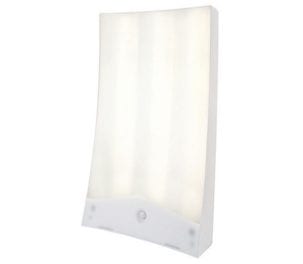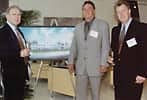Light therapy, when combined with behavioral sleep therapy modalities, is an invaluable tool to treat circadian rhythm disorders.
By Regina Ann Ledford, RN, BSN, RPSGT
 Sleep is as basic to holistic health as nutrition and exercise. Many articles have been written that tout sleep as the fifth vital sign, and rightly so, but is the nation taking notice? The effects of sleep disorders, whether behaviorally or physiologically mediated, affect every single individual, regardless of age, gender, ethnicity, culture, social standing, educational level, or health status. Unfortunately, many Americans consider sleep to be merely a quiet time of resting, a luxury, or a comfort measure, rather than a biologic necessity. In reality, sleep is a very active period of growth, cell regeneration, memory consolidation, physiologic recuperation, hormonal regulation, and psychological regrouping. Even with the knowledge gained in the sleep sciences over the past one-half century, there is an epidemic of sleeplessness that adversely affects the physical, social, and mental health of the afflicted and those around them. Contributing to this epidemic is a class of sleep disorders known as circadian rhythm sleep disorders. Fortunately, for patients affected by these disorders, treatment options are available, including behavioral recommendations and light therapy.
Sleep is as basic to holistic health as nutrition and exercise. Many articles have been written that tout sleep as the fifth vital sign, and rightly so, but is the nation taking notice? The effects of sleep disorders, whether behaviorally or physiologically mediated, affect every single individual, regardless of age, gender, ethnicity, culture, social standing, educational level, or health status. Unfortunately, many Americans consider sleep to be merely a quiet time of resting, a luxury, or a comfort measure, rather than a biologic necessity. In reality, sleep is a very active period of growth, cell regeneration, memory consolidation, physiologic recuperation, hormonal regulation, and psychological regrouping. Even with the knowledge gained in the sleep sciences over the past one-half century, there is an epidemic of sleeplessness that adversely affects the physical, social, and mental health of the afflicted and those around them. Contributing to this epidemic is a class of sleep disorders known as circadian rhythm sleep disorders. Fortunately, for patients affected by these disorders, treatment options are available, including behavioral recommendations and light therapy.
Disturbances in Circadian Rhythms
Circadian rhythm disorders include variants that range from a time-limited jet lag, possibly noted only during an annual family vacation, to life-altering medical conditions that affect sleep/wake homeostasis on a daily basis year round. Jet lag disorder, shift work disorder, delayed sleep phase disorder, and advanced sleep phase disorder are four of the best-known disorders.
Jet lag disorder. Most Americans suffer a 1-hour “jet lag” when the time is changed forward or backward in response to Daylight Saving Time. Depending on the number of hours and the duration of circadian disruption, it takes from 1 to several weeks for the average individual to recover from the effects of sleep/wake alterations, occurring when the external clock differs from the internal time-cued homeostatic responses. For most individuals, it is easier to adapt when moving westward across time zones or turning the clock back by 1 hour. With the exception of those with advanced sleep phase disorder, the average person finds that it is much easier to stay up later than their usual bedtime and then be able to arise at a later time the next morning, as compared to attempting to go to bed earlier and to arise earlier than the internal body clock is set to anticipate.
Shift work disorder. For the millions of American workers who must work the night shift or, worse, rotate shifts, their constantly altered sleep/wake schedules play havoc with their ability to attain sleep and to maintain wakefulness. Regardless of how hard the person has worked during the night or how tired they may feel, when this individual is preparing to sleep, the internal body clock may be saying that it is time to wake up. Even if sleep is initially attained due to exhaustion, individuals with shift work disorder often awaken after a few hours and find it impossible to return to sleep. When it is time to go to work that night, the body’s clock is calling out for sleep. During the night shift, the circadian push to sleep slows reflexes, decreases productivity, and diminishes cognition, and may ultimately have a negative impact on safety, productivity, and wellness.
Delayed sleep phase disorder. Adolescents have a biologically entrained circadian tendency for a later shift in their sleep/wake rhythms by at least a couple of hours. As a result, adolescents are more awake at the time considered by adults to be a “normal” bedtime. When morning arrives, this age group’s biologically preset circadian rhythms declare that it is still the middle of the night. The knowledge that the sleep sciences have accumulated includes a significant awareness of circadian rhythms and homeostatic changes in the adolescent physiology.
Advanced sleep phase disorder. Although it occurs in every age group, advanced sleep phase disorder is most prominent in the geriatric population. For individuals afflicted with this disorder, their body clocks are on an earlier schedule than desired. These individuals fall asleep much earlier than desired and awaken during the very early hours of the morning. The social life and safety of those with advanced sleep phase disorder may suffer from their altered sleep/wake schedule.
Treatment Options
Although a patient may relate classic symptoms of a specific sleep disorder, it may be determined that these symptoms are associated with separate disorders, such as sleep apnea, narcolepsy, or depression. Circadian rhythm sleep disorders may exist in isolation or as comorbidities with other sleep/wake disorders and medical conditions.
Behavioral Recommendations
Regardless of the diagnosis, it is important that these individuals follow sleep/wake behaviors that promote homeostasis. This is primarily accomplished by maintaining a regular bedtime and time of awakening to prevent shifting the internal body clock to a later or to an earlier time. Sleep is regulated by hormonal and temperature changes that are driven by light cues. When the bedtime and awakening hours drift gradually, the circadian rhythm also drifts in consequence.
Sudden changes in hours of sleep, such as those undertaken by shift workers who attempt to sleep during the day while working, but return to nighttime sleep on their nights off from work, confuse the internal homeostatic rhythms. The natural tendency will be to return to the intrinsic schedule of nocturnal sleep. For those individuals who are required to work at night, it is recommended that a routine schedule of day sleep be maintained, even on nights not working, in order to preserve circadian rhythm homeostasis as much as possible. Furthermore, for employees who must endure rotating shifts, every attempt to rotate forward with the clock should be undertaken.
Regardless of the sleep/wake schedule, other behavioral recommendations promote quality sleep. The bedroom should be a haven for sleep promotion. Keeping the bedroom cool, quiet, dark, comfortable, and stress-free will invite slumber. In general, caffeine should be limited to two servings daily and should be consumed earlier than 4 to 6 hours before bedtime. Caffeine-sensitive individuals should avoid caffeine altogether or drink only small amounts upon awakening. Alcohol should be used only in moderation and not within the last few hours before attempting to fall asleep. Although alcohol is sedating, it disrupts sleep quality. Nicotine is a stimulant and should be avoided, especially as the hour of sleep approaches. For those who welcome a midnight snack, a light fare at bedtime prevents hunger pangs during the hours of sleep; however, heavy meals increase body temperature and delay sleep onset. Eating at regularly scheduled mealtimes that correspond to the desired sleep/wake schedule promotes circadian rhythm homeostasis. Routine exercise also promotes sleep quality.
Light Therapy
As initially intimated, light exposure is critical in circadian rhythm homeostasis. Sunlight exposure upon arising promotes melatonin release at bedtime, causing a reduction in body temperature and subsequent sleep onset, if the environment is conducive to sleep. Avoidance of light as the hour of sleep approaches is important to prevent dampening the melatonin sleep-inducing mechanism. Night shift workers are encouraged to wear dark sunglasses on the short ride home and to use blackout curtains in the bedroom to promote sleep. Insomniacs are instructed to awaken early and to obtain sunlight exposure for 30 to 60 minutes to encourage sleep/wake homeostasis and to promote sleep onset at bedtime. Light therapy administered by a high-lux lighting device is a valuable resource that is presently underutilized.
A circuit of light therapy vendors at trade shows or a search of the Internet quickly reveals a variety of resources to utilize in treating patients with circadian rhythm sleep disorders. Light therapy devices emit 5,000 to 10,000 lux, much higher than standard artificial lighting. These devices are designed to mimic the light exposure produced by the sun and are available as desktop boxes, visors, lamps, and workstation components.
Using light therapy appropriately can assist the health care provider in managing circadian rhythm sleep disorders, and improving health and quality of life. Light therapy, recommended by the sleep professional at the appropriate phase of the circadian rhythm, will promote homeostasis of the sleep/wake cycle. Appropriately employed, light therapy reduces the effects of jet lag disorder. Utilizing light therapy enables shift workers to maintain wakefulness during work hours, with a dampening of the light therapy as the end of the shift draws near to promote sleep at the scheduled bedtime. Light therapy in the early morning, along with behavioral sleep modification, is available to assist the delayed sleep phase disorder patient in maintaining a preferred schedule for sleep, resulting in wakefulness during the day. Exposure to light therapy in the late evening can prolong wake time, assisting the individual with advanced sleep phase disorder to stay awake until a later bedtime and to subsequently stay asleep until the preferred awaking hour.
Concluding Comments
In addition to behavioral modifications and light therapy, licensed care providers educated in the sleep sciences may use chronotherapy and medication as needed to assist patients in attaining a desired sleep/wake schedule. As providers of health care and public health and safety advocates, it is always good practice to refer individuals to the Web site of the National Sleep Foundation at www.sleepfoundation.org as an invaluable educational resource.
Bibliography
Chesson AL, Littner M, Davila D, et al. Practice parameters for the use of light therapy in the treatment of sleep disorders. Sleep. 1999;22: 641-660.
The International Classification of Sleep Disorders: Diagnostic & Coding Manual. 2nd ed. Westchester, Ill: American Academy of Sleep Medicine; 2005.
Kryger MH, Roth T, Dement WC. Principles and Practice of Sleep Medicine. 4th ed. Philadelphia: Elsevier Saunders; 2005.
Sheldon SH, Ferber R, Kryger MH. Principles and Practice of Pediatric Sleep Medicine. Philadelphia: Elsevier Saunders; 2005.
Regina Ann Ledford, RN, BSN, RPSGT, has been practicing in the nursing profession for 25 years, with the last 10 years of her career spent working in the field of sleep medicine. She is currently enrolled in the Master of Science in Nursing, Family Nurse Practitioner Program at Graceland University. She plans to practice in sleep medicine and can be reached at [email protected].



